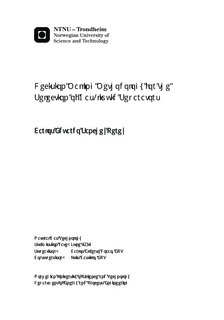Decision Making Methodology for the Selection of Gas-liquid Separators
Master thesis
Permanent lenke
http://hdl.handle.net/11250/234861Utgivelsesdato
2012Metadata
Vis full innførselSamlinger
Sammendrag
Gas liquid separation is a critical operation in many industries, including the gas and oil industry. In fact, costly equipment like heat exchangers and compressors rely on the good performance of gas scrubbers. In the particular case of Norway, most of these operations are offshore where the plot area is critical. On the other hand, the separation of liquid droplets from the gas stream is generally performed in bulky and heavy pressure vessels. More compact technologies are emerging though. However, it is becoming difficult to select the appropriate separator and it is required engineering experience. Therefore, the objective of this project is to develop mathematical models for selected technologies to facilitate the selection. The technologies selected were the traditional knitted mesh separator and the recent multi-cyclone scrubber. The models provide the basic dimensions, weight, purchase and installed costs for both scrubbers. The results of both models were compared and extrapolated to hypothetical situations to establish when a compact technology becomes competitive. For this comparison, gas load factor and costs per flow rate were used. In fact the vessel compactness is related to the former. Therefore, it is intended to have values much higher than 0.107 m/s corresponding to traditional separators at atmospheric pressure. In fact, a factor slightly higher than 0.14 m/s would make very competitive multi-cyclones; which can be achieved at pressures higher than 70-80 bar. Furthermore, technologies with factors up 0.5 to 1 m/s might be much more attractive. Nevertheless, there would be restrictions in achieving the maximum gas load factor expected.
